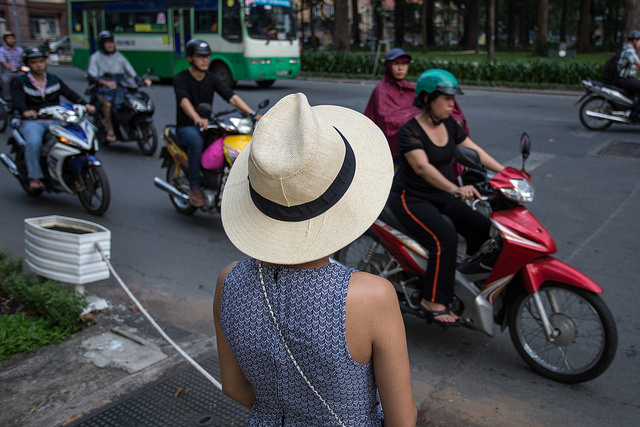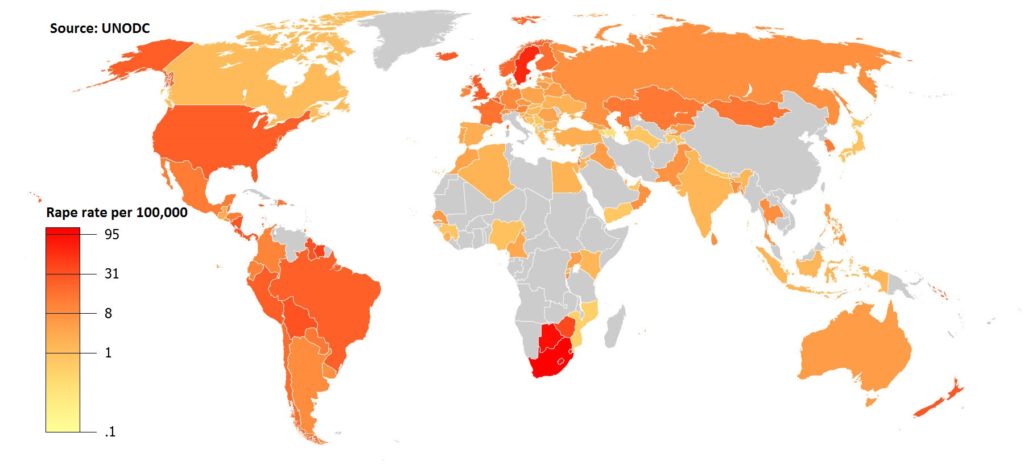Solo Travel, Sexual Assault and the Conversation We’re Not Having

Among independent travelers under 35, a majority of those taking to the road are women. This often surprises people because our narrative surrounding female travel is one which is almost unavoidably linked with the dangers, risks and fears both real and imagined that go with travel. Every travel blogger who has spent any time engaged in conversations around travel or travel safety will have had to address and discuss the topic of female safety on the road. Similarly, every time there is a violent attack or high profile assault against a female traveler, or travelers, our assumptions and fears about female travel – particularly solo travel – are confirmed with a wave of articles and news coverage.
As a feminist, I’m a strong believer that conversations about sexual assault, sexual health and sexuality are an essential part of our narrative and a core topic that we must tackle and discuss more openly. As a man, I’m also acutely aware that the world I exist in, is a world that makes it difficult for me to fully understand the trials, risks, concerns and daily tribulations that women face. However, this also is often extended to mean that outside of general affirmation with whatever narrative is being put forward by women, I’m not allowed to weigh in on the topic or to offer my own critical voice. In recent months, I’ve mentioned the topic outlined in this post in talks with other travelers and the response has been extremely mixed and skeptical.
Despite this, I believe that a core aspect of the travel+sexual assault+women’s safety discussion is missing: context. I view this as an extension of the overall safety discussion tied to travel/solo travel. After all, when I look at and discuss travel, I also have to tackle the fears, particularly among Americans, that the world they’ll be exploring beyond America’s borders is much more dangerous and unsafe than the US. I have to work to educate people that the United States, and the city of Phoenix where I come from, are often far more dangerous than most of the destinations travelers might seek to explore and highlight that in many ways the individual who embarks on a reasonably well-thought out trip, even alone, is very likely more safe than an individual living and working within one of America’s great cities on a daily basis.
[blogoma_blockquote]”That is part of what irks me about this discussion: being “alone” is not the issue. Travel abroad is not the issue. The issue is treatment of women. And we should be using this media spotlight to as a springboard to discussing how we can fix it.”
– Jodi of LegalNomads on Solo Travel [/blogoma_blockquote]
To this end, I grow increasingly more confident that the narrative we have about women, travel, solo travel and sexual assault needs to change. Not because there is not a profound and utterly heartbreaking risk of women facing sexual assault while traveling, but because that risk is very likely on par with, or potentially even lower than, what they would be experiencing if they did not travel. Which, to more explicitly state my belief, is that women traveling is no less risky and may even be safer than women going about their daily routine.
Unfortunately, it is extremely difficult to concretely say if this assumption is founded, or unfounded, in no small part because we know so little about sexual assault and because we lack any aggregate research on the reach and proliferation of sexual assault and harassment. We do know that certain cultures have significantly higher levels of sexual harassment and others significantly higher levels of sexual assault. But we do not know if female travelers status as a cultural outside, makes them more or less susceptible. We also often neglect or misportray the sources of sexual assault because they are, to put it bluntly, complex and quite uncomfortable. One key element though that often re-surfaces is the tragic reality that a large portion of sexual assaults are not random attacks on a street or in a bar. They come from people who know the victim and are often perpetrated by individuals with whom the individual is or has engaged in a relationship with.
So, before I we get to far into the conversation, let’s look at what we do know pulled from some of the few global-facing sources.
FROM THE WHO (Fact sheet N°239, Updated January 2016):
- Recent global prevalence figures indicate that about 1 in 3 (35%) of women worldwide have experienced either physical and/or sexual intimate partner violence or non-partner sexual violence in their lifetime.
- Most of this violence is intimate partner violence. Worldwide, almost one third (30%) of women who have been in a relationship report that they have experienced some form of physical and/or sexual violence by their intimate partner.
- Globally, as many as 38% of murders of women are committed by an intimate partner.
- Situations of conflict, post conflict and displacement may exacerbate existing violence, such as by intimate partners, and present additional forms of violence against women.
- Between 15% of women in Japan and 71% of women in Ethiopia reported physical and/or sexual violence by an intimate partner in their lifetime
- Between 0.3–11.5% of women reported sexual violence by someone other than a partner since the age of 15 years
- The first sexual experience for many women was reported as forced – 17% of women in rural Tanzania, 24% in rural Peru, and 30% in rural Bangladesh reported that their first sexual experience was forced
VISUALIZING RISK (UNODC/Tracy Hunter):
SEXUAL ASSAULT IN THE US (WH Report):
- Women and girls are the vast majority of victims: nearly 1 in 5 women – or nearly 22 million – have been raped in their lifetimes .1 Men and boys, however, are also at risk: 1 in 71 men – or almost 1.6 million – have been raped during their lives.
- Women of all races are targeted, but some are more vulnerable than others: 33.5% of multiracial women have been raped, as have 27% of American Indian and Alaska Native women, compared to 15% of Hispanic, 22% of Black, and 19% of White women.
- Most victims know their assailants.
- The vast majority (nearly 98%) of perpetrators are male.
- Young people are especially at risk: nearly half of female survivors were raped before they were 18, and over one-quarter of male survivors were raped before they were 10. College students are particularly vulnerable: 1 in 5 women has been sexually assaulted while in college.
- Repeat victimization is common: over a third of women who were raped as minors were also raped as adults.
- The majority of rape and sexual assault victims are young – between the ages of 16 and 24. The Centers for Disease Control and Prevention (CDC) reports that 80% of female victims were raped before they turned 25, and almost half were raped before they were 18.11 Among men, 28% were raped before they were 10.12
- College students are especially at risk: 1 in 5 women has been sexually assaulted while in college.
So, what can we draw from this? How can it flavor how we discuss female independent and solo travel? To me it re-affirms that as both a culture and as a civilization we have a heart-breaking and utterly unnecessary problem we’ve yet to properly face. One that is pervasive, destructive, and reaches into all aspects of the globe. It re-affirms that women live their daily lives going out of their way to keep themselves safe and working within the confines of social and geographic geographies to navigate their daily lives safely (eg: this piece). But, what it also indicates, to me at least, is that contrary to the social narrative that has existed for more than a century, solo and independent female travel does not increase the risk of assault and sexual violence. It also re-affirms my growing suspicion that it actually reduces these risks by eliminating some of the most-common offenders – the people women know.
[blogoma_blockquote]Female fearfulness is a cultural construct, instituted and maintained by
both men and women in the interests of the dominant, male group. The
myth of female victimhood is emphasised in order to keep women under
control, so that they plan their activities, remain in view, tell where they
are going, how they are getting there, when they will be home
– Germaine Greer, The Whole Woman, pp. 355[/blogoma_blockquote]
Of course, there are confounding and complicating factors. The alcohol, bar, and at times drug-infused nature of the hostel scene fosters an environment that is not unlike that on college campuses – a hotbed for sexual assault. The widely differing cultural and sexual norms also create situations where added risks may arise. But, I think that we can discuss these as considerations that factor into independent and solo travel, without continuing to foster a sense of fear and intimidation that keeps women from striking out and exploring the world at large or leaves them constrained to desperately seeking for travel companions – male or otherwise – who can accompany them, often at the cost of rich and rewarding experiences while likely adding only minimal added safety – if any at all.
At the end of the day, I’ve seen the devastating impact of sexual and physical assaults. It is never simple. It is never deserved. It is never justified. It is long lasting. It is horrifying. It is rarely talked about and it is profoundly shameful that for as far as we have advanced as a species we continue to struggle with the simplest of things: a common respect for each other and each other’s bodies. This post is about furthering that discussion and making sure that we seek to change the way we discuss travel in the context of sexual assault, harassment, and violence.
So, moving forward, what will my answer be when asked if it’s safe for women to travel solo or in pairs? It won’t be the standard simple yes. It’ll be yes, it is, at least in comparison to staying at home. That key point of differentiation saddens me in and of itself, but is, I believe, a likelihood it’s long past time we accepted.
P.S. – In the time between when I wrote this post and published it, this article, “Why is travelling alone still considered a risky, frivolous pursuit for women?” at the Guardian was published. It’s a great write up by Laura Bates that also covers similar aspects of this issue.


